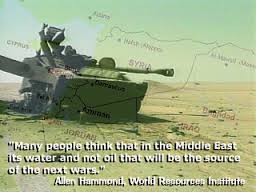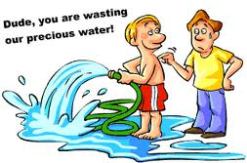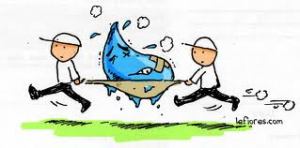For my attitude analysis paper, I chose to write about the misuse of water topic under the “Natural Resources in Egypt” theme. I chose this topic specifically because my mother’s voice rang a bell in my head when I was going through the themes to decide on the topic; “don’t leave the water tap open, you won’t find water tomorrow, and each drop of water is precious, think of others who can’t find this drop of water.” I believe that Egyptians have this negative attitude toward natural resources; taking them for granted and we don’t appreciate their presence. According to a housing ministry project manager; “40 percent of Cairo’s drinking water is wasted either as a result of deteriorating supply networks or bad social habits like using water to wash building stairwells and cars.”

 With all the ongoing concerns regarding the upcoming “water war” and given that our attitude toward the use of water is an implicit attitude that we unconsciously practice and we don’t think about it most of the time unless someone picks on us or there is a water cut.
With all the ongoing concerns regarding the upcoming “water war” and given that our attitude toward the use of water is an implicit attitude that we unconsciously practice and we don’t think about it most of the time unless someone picks on us or there is a water cut.

Studying social psychology would help me understand how this attitude does is formed and reinforced in our society, the role of social influence in forming and maintaining our construal of natural resources and it will provide me with the proper techniques that would help in tackling and changing this attitude and behavior.
I’ll target the new moms and moms to be. I believe that this target group would be the most interested in this topic and they would highly relate to it since they would want to secure the future of their kids and the coming generations more than anyone else. Moreover, this way we will be able to change their attitudes themselves, they would influence others around them and they will use operant conditioning with their children to reinforce positive attitudes toward the use of water. Moreover, they would adopt attitude inoculation strategy to help their children resist any peer pressure that make them change their attitude to a negative one a make them defend the positive attitude instead. That’s basically why I believe that they are the best group to target.
I think starting with changing the attitudes first would be better in this case because once people realize the importance of water, realize that it’s scarce and that in the future we would fight to get this drop of water. They won’t be as careless and they’ll start changing their behavior and work on saving the water. Moreover, according to the reactance theory, people don’t want to feel that their freedom to perform a behavior is threatened if we managed to change their attitude first they will automatically change their behavior without resisting and insisting on doing the negative behavior because they would think that they freely choosing not t waste water and not just because someone is telling them to d so.
Analyzing the three components of attitudes would help in identifying how much each component influences the existing attitude. Accordingly, we will choose the right means of changing this attitude because we’ll have a better understanding of the nature and origin of the attitude.
First, the cognitive component, it is basically the beliefs that the people have about the properties of the attitude object. Egyptians’ thoughts regarding the existence of water are that it’s endless. It is something that we’ll always have. This stems from the fact that Egypt has the river Nile which they assumed that it’s an endless source of water. They assumed also that our geographical position makes the water available forever. They think also that the high dam will keep doing its job forever. Therefore, I could infer that they have high cognitive based attitude. I believe that it would be successful if we managed to change these wrong believes and communicated though facts and figures that water is scarce and give them scientific proofs that water would diminish if we didn’t use it conservatively. In this case, persuasive communication would work using the central route to persuasion according to the elaboration likelihood model. Therefore, we would let our audience use their controlled thinking instead of automatic thinking in order to see think of the argument rationally and be aware of the heuristics and schemas to control them. However, as we know, we can’t really control the need for cognition. It necessitates making extra effort to increase the personal relevance to the topic and I believe that it would be easy if we understood our target audience very well and knew the areas of their interest to capture their attention.
Second, the affective component, it is people’s emotional reactions (feelings, values and conditioning) toward the attitude object. In our case Egyptian are generally generous, however, they do it in the wrong way. They love to see a lot of the water flowing when they are bathing for example or while washing the dishes, cleanness is defined by the amount of water flowing regardless if they are actually using it or not. The resulted behaviors are maintained simply because they are not met with some kind of punishment instead they may be positively reinforced. In this way, I believe that if we managed to change the behavior using emotions by some fear arousal it would work well. We need to touch their emotions and make them fear the absence of water. Water is life, no water no life; as simple as that. . However, they might use thought suppression in order to escape their negative thoughts of what might result in the absence of water. Therefore, we definitely need to provide our recommendations and suggestions on how to use the water and save it for the next generations that would give them hope and reduce their fear.
Third, behavioral component, it’s how people act toward the attitude object. As mentioned above, our behavior toward the use of water results from an implicit attitude. This means that we don’t actually realize that we have a negative attitude toward the use of water unless we start referring to our previous behaviors and actions. So one might start thinking of the countless times that he/she left the tap open without using the water or even remember the times that they used to play water fight games without caring to waste water. According to the self-perception theory, under such circumstances we don’t need to see how we behaved before in order to understand how we really feel about the use of water. Given the nature of the target audience, mothers to be, new mothers; I believe that using cognitive dissonance would work well as we would increase their internal justifications by making them feel guilty for not doing the right thing while giving their children moral speeches on not to waste the water. Therefore, they’ll actually want to change their behavior while priming their kids.
In a nutshell, our negative attitude toward water need a growing mindset one that would accept the fact that we are able to be the change we are able to become better. Nothing is called we have this attitude because we are Egyptians. Don’t blame culture we are the culture we influence each other and who decide to conform to certain schemas. By targeting those moms who will teach the next generations, schemas will change, attitudes will change and the culture would change accordingly.
